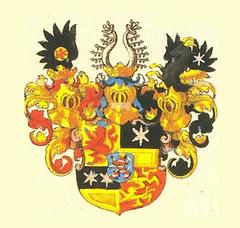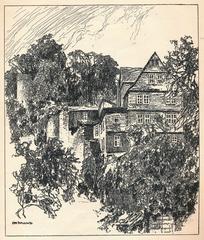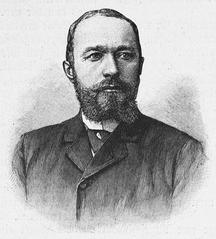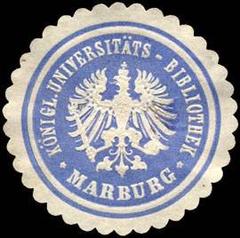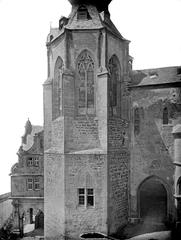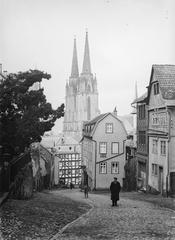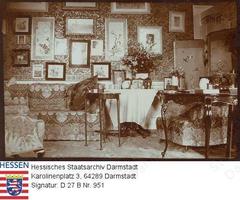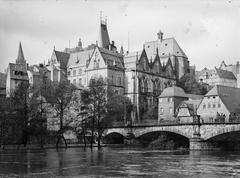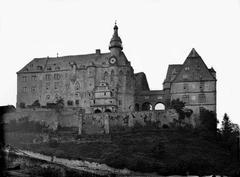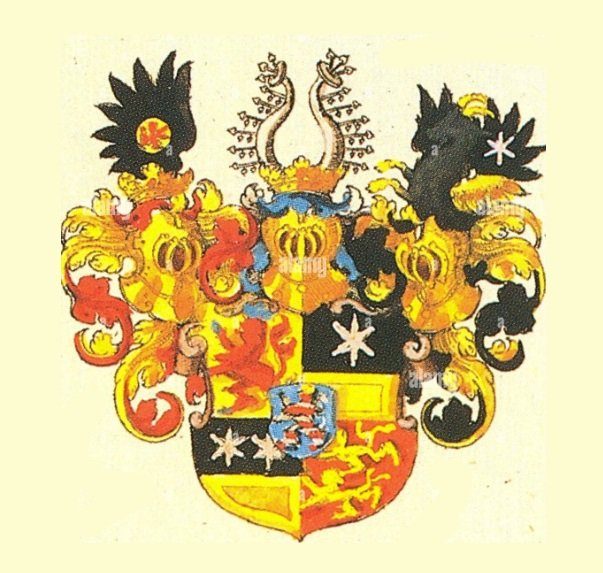
Marburg Castle Visiting Hours, Tickets, and Historical Guide
Date: 14/06/2025
Introduction
Marburg Castle (Landgrafenschloss Marburg) stands as a commanding symbol of medieval heritage and cultural significance in Marburg, Germany. Perched atop Schlossberg hill, the castle not only offers sweeping views over the historic town and Lahn Valley, but also invites visitors on a journey through more than eight centuries of architectural and regional history. Originally constructed in the 11th century as a wooden fortification and later rebuilt in stone, Marburg Castle became the principal residence of the Landgraves of Hesse and was a key site during the Protestant Reformation, most notably as the setting for the Marburg Colloquy in 1529 (Wikipedia; nomads-travel-guide.com).
Today, the castle serves as both a museum and a cultural landmark. The Marburg University Museum for Cultural History, located within its historic walls, showcases a diverse array of artifacts and exhibitions that illuminate the social, artistic, and religious heritage of Hesse. Managed by Philipps-Universität Marburg, the museum highlights the interplay of Romanesque, Gothic, and Renaissance architectural styles, with notable features such as the Gothic Hall and castle chapel (uni-marburg.de).
This comprehensive guide covers everything you need to plan your visit: opening hours, ticket options, guided tours, accessibility information, nearby attractions, and the rich historical context that makes Marburg Castle one of Germany’s most iconic destinations (whichmuseum.com; hidden-germany.de).
Table of Contents
- Introduction
- Origins and Early Development
- The Landgraves of Hesse and the Castle’s Golden Age
- The Marburg Colloquy and the Reformation
- Military and Political Roles Through the Centuries
- 19th and 20th Century Transformations
- Visiting Marburg Castle: Hours, Tickets, and Tours
- Nearby Attractions and Events
- Architectural Highlights and Preservation
- Legends, Folklore, and Cultural Impact
- The Marburg University Museum for Cultural History
- Visitor Tips and Recommendations
- Frequently Asked Questions (FAQ)
- Conclusion
- Sources
Origins and Early Development
Marburg Castle traces its beginnings to the 11th century, when it was established as a wooden fortification on Schlossberg hill, 287 meters above sea level (Wikipedia). Its strategic vantage point over the Lahn valley and the medieval town made it a vital defensive and administrative center (hidden-germany.de). By the late 12th century, the structure was reconstructed in stone, featuring a square keep, fortified walls, and residential towers. The castle expanded over time to include a chapel and administrative quarters (castrumtocastle.com).
The Landgraves of Hesse and the Castle’s Golden Age
From the 13th century onward, Marburg Castle served as the principal residence of the Landgraves of Hesse. Under Landgrave Henry I, the site was further fortified and expanded to become a political and administrative hub of the Holy Roman Empire (nomads-travel-guide.com). Distinctive features from this period include the octagonal tower, the Gothic Knights’ Hall, and the 1288 chapel, emphasizing the castle’s dual function as both fortress and noble residence (castrumtocastle.com).
The Marburg Colloquy and the Reformation
In 1529, Landgrave Philip I hosted the Marburg Colloquy at the castle. This historic summit brought together leading Protestant reformers, including Martin Luther and Ulrich Zwingli, in an attempt to unify their theological positions (nomads-travel-guide.com). Although complete agreement was not reached, the event cemented Marburg Castle’s place in religious and intellectual history. The castle museum commemorates this significant moment through dedicated exhibits (knightstemplar.co).
Military and Political Roles Through the Centuries
The castle’s strategic significance continued through the centuries, including occupation by Swedish forces during the Thirty Years’ War (knightstemplar.co). While the Landgraves eventually relocated their residence, the castle persisted as a military and administrative site, falling partially into disrepair by the 18th century (theadventurelion.com).
19th and 20th Century Transformations
Restoration efforts in the 19th century, inspired by the Romantic movement, preserved and revived the castle’s Romanesque, Gothic, and Renaissance elements (theadventurelion.com). During World War II, Marburg Castle was used as a military hospital and later became associated with the compilation of the “Marburg Files” in 1945 (Wikipedia).
Visiting Marburg Castle: Hours, Tickets, and Tours
Opening Hours
- April to October: Tuesday to Sunday, 10:00–18:00
- November to March: Tuesday to Sunday, 10:00–16:00
- Closed on Mondays (whichmuseum.com)
Hours may be adjusted for public holidays or special events. Always confirm on the official museum website before your visit.
Tickets
- Adults: €7
- Reduced (students, seniors): €4–5
- Children under 12: Free
- Groups (15+): €5 per person
- Family and combined tickets: Available for both the castle and Marburg Art Museum
Tickets can be purchased at the entrance or online. Advance booking is recommended for groups and guided tours.
Guided Tours
- Regular guided tours (approx. 50 minutes) are available, focusing on the history, architecture, and legends of Marburg Castle.
- Audio guides are offered in multiple languages.
- English-language tours are available but may require advance booking (whichmuseum.com).
Accessibility
While the castle’s medieval design presents challenges, ongoing improvements aim to enhance accessibility. The approach is steep and some areas feature uneven flooring and narrow staircases. Contact the museum for the latest updates on accessible routes and facilities.
Nearby Attractions and Events
- Marburg Old Town (Altstadt): Picturesque medieval streets, timber-framed houses, and vibrant market squares.
- Elisabethkirche (St. Elisabeth’s Church): A renowned Gothic landmark.
- University of Marburg: Historic campus buildings nearby.
- Seasonal Events: The castle hosts medieval festivals, concerts, and art exhibitions; check the event calendar for details.
Other attractions include the Mineralogical Museum, Marburger Kunstverein, and the Museum of Art and Cultural History.
Architectural Highlights and Preservation
Marburg Castle’s architecture showcases a blend of Romanesque, Gothic, and Renaissance styles:
- Gothic Hall: High ribbed vaults and pointed arches.
- Chapel of St. Elisabeth: Consecrated in 1288, with medieval frescoes.
- Renaissance Staircase: Ornate sandstone balustrades.
- Defensive Features: Massive curtain walls, towers, and remnants of a moat and drawbridge.
- Courtyards: Cobblestoned, with historical wellheads and decorative stonework.
Ongoing preservation ensures these features remain accessible to visitors (knightstemplar.co).
Legends, Folklore, and Cultural Impact
The Brothers Grimm, who studied in Marburg, drew inspiration from the castle, contributing to its rich folklore. Marburg Castle remains a cultural icon, celebrated in literature and art, especially for its panoramic sunset views (hidden-germany.de).
The Marburg University Museum for Cultural History
Historical Background
Housed in the Wilhelmsbau wing of the Landgrafenschloss, the Marburg University Museum for Cultural History offers a window into centuries of regional art, culture, and academic tradition. The castle itself dates to the 11th century, with archaeological remains from even earlier times (placesofgermany.de).
Cultural and Academic Significance
Managed by Philipps-Universität Marburg (est. 1527), the museum integrates scholarly research with public education. The building is a national cultural monument, featuring the Fürstensaal (Prince’s Hall), one of Germany’s largest secular Gothic halls (marburg.de).
Collections and Exhibitions
- Permanent Exhibitions: Church art, regional history, historic furniture, and applied arts (trip101.com). The Abgusssammlung (plaster cast collection) supports research and education.
- Temporary Exhibitions & Events: Workshops, art talks, and special exhibitions such as “Was ist Kunst? – 40 Jahre KunstWerkStatt Marburg” (uni-marburg.de).
- Architectural Features: The Prince’s Hall and the castle chapel, both outstanding examples of Gothic design, as well as castle grounds undergoing revitalization.
Visiting Hours and Tickets
- Regular Hours: Tuesday to Sunday, typically 10:00–18:00 (April–October), 10:00–16:00 (November–March). Closed Mondays.
- Tickets: Purchase onsite or online via the official museum website. Discounts for students, seniors, and groups; special exhibitions may require separate tickets.
Accessibility
A major redevelopment is underway to improve barrier-free access, including new elevators and visitor facilities (marburg.de). Some areas may be closed for renovations—check ahead for current information.
Guided Tours and Educational Programs
Guided tours are available for individuals and groups, and should be booked in advance via the museum’s contact page.
Visitor Tips and Recommendations
- Best Visiting Period: Spring or summer for longer hours and pleasant weather.
- Crowds: Visit on weekdays or mornings to avoid peak times.
- Footwear: Wear comfortable shoes for navigating steep and uneven terrain.
- Refreshments: No café onsite; explore the old town for dining options.
- Photography: Generally permitted; check for restrictions in some areas.
- Accessibility: If mobility is a concern, confirm current routes and facilities due to ongoing renovations.
Frequently Asked Questions (FAQ)
Q: What are Marburg Castle’s opening hours?
A: April–October: Tue–Sun, 10:00–18:00; November–March: Tue–Sun, 10:00–16:00; closed Mondays.
Q: How can I purchase tickets?
A: Tickets are sold onsite or online; advance booking is recommended for groups and special exhibitions.
Q: Are guided tours available in English?
A: Yes, though availability varies—contact the museum in advance.
Q: Is the castle accessible for visitors with disabilities?
A: Accessibility is improving but remains limited due to the historic structure and hilltop location.
Q: Are there parking facilities near Marburg Castle?
A: Parking is available in Marburg; a walk uphill is required to reach the castle.
Contact and Further Information
Conclusion
Marburg Castle is more than a medieval stronghold—it is a living monument that encapsulates centuries of Hessian history, architectural splendor, and cultural innovation. Its role as a princely residence, a site of religious debate, and a modern museum make it a must-visit for anyone interested in Germany’s heritage. With practical visitor information, accessible museum collections, and a central location within Marburg’s old town, the castle offers a rich and varied experience for travelers, students, and cultural explorers alike.
For the latest updates, detailed schedules, and exclusive content, consult the official sources listed below. Enhance your visit with the Audiala app for audio tours and insider tips, and explore our related articles for more on Marburg’s attractions and German castles.
Sources
- hidden-germany.de
- Deutsche Märchenstraße
- Philipps-Universität Marburg Museum
- WhichMuseum
- Wikipedia
- Knightstemplar.co
- TravellersWorldwide
- placesofgermany.de
- trip101.com
- marburg.de
- castrumtocastle.com
- theadventurelion.com
- nomads-travel-guide.com
